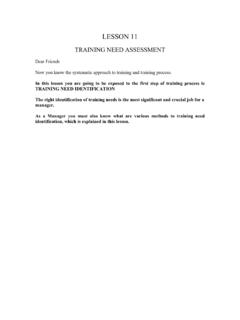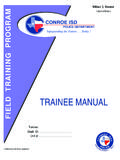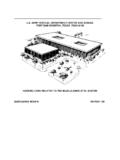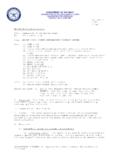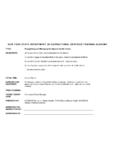Transcription of LESSON 13 TRAINING DEPARTMENT - About …
1 LESSON 13. TRAINING DEPARTMENT . Hi Friends, In previous few lessons you have understood the procedure followed for TRAINING and Development. After reading this LESSON you will be able to plan and organize TRAINING DEPARTMENT in any organization wherever you will go for work. Before understanding what will make a effective TRAINING DEPARTMENT let us first understand role and activities done by HRD and TRAINING specialist DEPARTMENT . ROLE AND ACTIVITIES OF HRD AND TRAINING SPECIALIST. HRD is based on the faith in the inherent potential in every human which can be , manifested by giving right direction and orientation. At the same time human resource is unpredictable resource which has unlimited potential. These two statements gently hint that the organisational efficiency can be improved by optimising this resource as it is the only resource which can be adjusted and modified to meet the challenging technological and socio-economic environment.
2 This recognition of emphasis on human resource development has created a need for appraisal of present competence future demand and maintenance of resources for long term benefits. HRD process maximise the use of human resource by way of optimising competence of available human resource, improving the competence for future challenges and utilising unemployed resource HRD, thus performs the role of personnel management as well as TRAINING and Development DEPARTMENT and it therefore, needs to be studied, analysed minutely and accurately before deciding the real roles and activity of DEPARTMENT The roles and activities of HRD will mostly depend on the HRD mechanism being utilised, the HRD needs of the organisation and the facilities, opportunities provided Thus the role of HRD starts from the analysis of organisational objectives/goals, in par with characteristics of available resources and desired specifications manpower planning recruitment, placement, appraisal reward.
3 Punishments and maintenance of resource is one aspect of HRD accountability, where as. organisational climate and opportunity are another. ROLE AND ACTIVITIES OF HRD DEPTT. Accordingly the main roles of HRD can be listed as 1. Human resource planning 2. Human resource accounting 3. Human resource allocation and role planning Human resource TRAINING and development Human resource maintenance 4. Climate development of HRD. T & D DEPARTMENT . The growth of organization depends on: 1. Strategic decisions taken by management and 2. Implementation of these decisions by employees. The TRAINING and development activity is a vital link to facilitate the implementation process by imparting the required TRAINING to improve the competence of the employees & to effectively implement the management decisions. Well trained people can be somewhat effective without well prepared strategic plans or land organizational culture but without strategic knowledge and skill every thing may collapse.
4 Similarly good relations alone can always do good. A truety competitive edge comes from the people who know what they are supposed to do and how exactly that is to be done. T & D helps the people to learn and develop this capability to bring dynamism in the organization. Managing a Small TRAINING DEPARTMENT Making the Most of Your Resources Today's organizations are expecting people to do more with less. TRAINING departments are no exception. In fact, one fourth of all TRAINING departments in the United States consist of only one trainer. With small businesses on the rise, there are likely to be even more small TRAINING departments in the future. How can a TRAINING staff of only one to three people with a broad range of responsibilities-- ensure that it makes a significant contribution to its organization? This chapter explores strategies that trainers in small departments have used successfully by.
5 Readers will learn keys to working with internal subject matter experts through a train-the-trainer process, as well as keys to working with external consultants and other external resources. Successful strategies of small TRAINING departments are as varied as the individuals involved. Much more so than in large departments, trainers in small departments have a chance to place their unique stamp on an organization. The cases in this book illustrate the variety of approaches small departments use to ensure a big impact. The following key strategies are essential to the small TRAINING organization's success: Determining priority TRAINING needs Establishing your credibility and building a strong base of support for your efforts Determining the best resource strategy for using internal and external resources Maintaining your resilience and a positive attitude This chapter briefly explores these strategies, which have been used successfully by the case authors and by other trainers in small departments.
6 In addition, it will provide detailed guidance About establishing an effective train-the-trainer process for internal resources and selecting and working with external resources to expand your staff's capacity and capability. Determining Priority TRAINING Needs A thorough TRAINING needs assessment, identifying specific TRAINING needs that if met or unmet would impact the organization most, is the foundation for a successful small TRAINING DEPARTMENT . In doing a needs assessment, it is essential to use a variety of methods, both formal and informal, to gain a clear, complete picture. The cases in this book illustrate the range of methods for conducting a needs assessment. Strategies may include using paper and pencil written surveys, interviewing employees and managers, analyzing problems encountered, or doing research related to the problem or issue.
7 A. critical strategy in assessing needs and implementing performance-based TRAINING is conducting a thorough job and task analysis of performance requirements. See Gettle's Monsanto case for an excellent introduction to developing performance- based TRAINING . Companies that are pursuing ISO quality certification can identify TRAINING needs by creating job profiles and TRAINING plans relating to ISO certification. For more information on ISO certification and how it relates to TRAINING needs, see Gettle's chapter on Monsanto; Balling's chapter on Collagen; Maxwell and Jost's chapter on Nortel; and Monnin's chapter on Strategies for the 90s. Another helpful approach to assessing needs and clarifying priorities is to create a TRAINING advisory board. The chapters by Arnold on Navistar, Taylor on LWCC, and McCoy on UNUM provide insights into how advisory boards can be help set your direction.
8 Other approaches to needs assessment are more informal. For example, personal intuition based on your experience working in the business to identify needs or TRAINING strategies is valuable. The cases on American Honda, Nortel, and Logitech all illustrate how the authors used their experience in the company to help them understand TRAINING needs. Listening to your internal customers also can help identify problems that might have TRAINING implications. Teaching or facilitating TRAINING allows the lone trainer to get a pulse of the organization and learn first hand About the issues facing employees. Tuning into the recommendations of employees who attend outside TRAINING programs provides clues About potential high-impact TRAINING interventions. Nancy Nunziati discovered a TRAINING program that ultimately helped to move Logitech's culture to one of increased accountability because she listened to employees who had attended a time management program and given it rave reviews.
9 (See Nunziati's Logitech case.). In many instances, a small organization may not have the internal resources needed for a detailed needs assessment that can identify the best way for TRAINING to support the business objectives. Linda Taylor's chapter on LWCC is an excellent example of using a consultant, who already had the ear of the company president, to conduct a TRAINING needs assessment. Taylor shows that as a result of documenting needs, she was able to document the need and gain four additional TRAINING staff members. Katie O'Neill at Rock-Tenn and Millar Farewell of American Honda also relied on outside consultants to help them clarify a business need and determine the best approach to solving a TRAINING problem. A key part of conducting a needs assessment is determining priorities because it will be important to focus TRAINING resources where they can do the most good.
10 First, it is essential to examine business data that indicates the severity of problems or highlights potential opportunities and their potential impact on the business. Farewell's case on Honda is a good example of how to collect data to determine the impact of electrical trouble shooting skills on service to motorcycle owners. A second aspect of clarifying priorities is to determine problems where TRAINING can actually have an impact and to identify all the solutions needed to change performance. Sometimes the best solution is not a TRAINING program, but TRAINING along with other interventions -- such as increasing the staff or providing appropriate incentives to perform in the desired way. TRAINING often needs to be accompanied by other follow-up actions to change employee behavior. See McCoy's case on UNUM to learn how call monitoring by supervisors following telephone skills TRAINING can lead to improved customer relations.
